Dian Yang
EVENet: Evidence-based Ensemble Learning for Uncertainty-aware Brain Parcellation Using Diffusion MRI
Sep 11, 2024



Abstract:In this study, we developed an Evidence-based Ensemble Neural Network, namely EVENet, for anatomical brain parcellation using diffusion MRI. The key innovation of EVENet is the design of an evidential deep learning framework to quantify predictive uncertainty at each voxel during a single inference. Using EVENet, we obtained accurate parcellation and uncertainty estimates across different datasets from healthy and clinical populations and with different imaging acquisitions. The overall network includes five parallel subnetworks, where each is dedicated to learning the FreeSurfer parcellation for a certain diffusion MRI parameter. An evidence-based ensemble methodology is then proposed to fuse the individual outputs. We perform experimental evaluations on large-scale datasets from multiple imaging sources, including high-quality diffusion MRI data from healthy adults and clinically diffusion MRI data from participants with various brain diseases (schizophrenia, bipolar disorder, attention-deficit/hyperactivity disorder, Parkinson's disease, cerebral small vessel disease, and neurosurgical patients with brain tumors). Compared to several state-of-the-art methods, our experimental results demonstrate highly improved parcellation accuracy across the multiple testing datasets despite the differences in dMRI acquisition protocols and health conditions. Furthermore, thanks to the uncertainty estimation, our EVENet approach demonstrates a good ability to detect abnormal brain regions in patients with lesions, enhancing the interpretability and reliability of the segmentation results.
Application Research On Real-Time Perception Of Device Performance Status
Sep 05, 2024



Abstract:In order to accurately identify the performance status of mobile devices and finely adjust the user experience, a real-time performance perception evaluation method based on TOPSIS (Technique for Order Preference by Similarity to Ideal Solution) combined with entropy weighting method and time series model construction was studied. After collecting the performance characteristics of various mobile devices, the device performance profile was fitted by using PCA (principal component analysis) dimensionality reduction and feature engineering methods such as descriptive time series analysis. The ability of performance features and profiles to describe the real-time performance status of devices was understood and studied by applying the TOPSIS method and multi-level weighting processing. A time series model was constructed for the feature set under objective weighting, and multiple sensitivity (real-time, short-term, long-term) performance status perception results were provided to obtain real-time performance evaluation data and long-term stable performance prediction data. Finally, by configuring dynamic AB experiments and overlaying fine-grained power reduction strategies, the usability of the method was verified, and the accuracy of device performance status identification and prediction was compared with the performance of the profile features including dimensionality reduction time series modeling, TOPSIS method and entropy weighting method, subjective weighting, HMA method. The results show that accurate real-time performance perception results can greatly enhance business value, and this research has application effectiveness and certain forward-looking significance.
 Add to Chrome
Add to Chrome Add to Firefox
Add to Firefox Add to Edge
Add to Edge